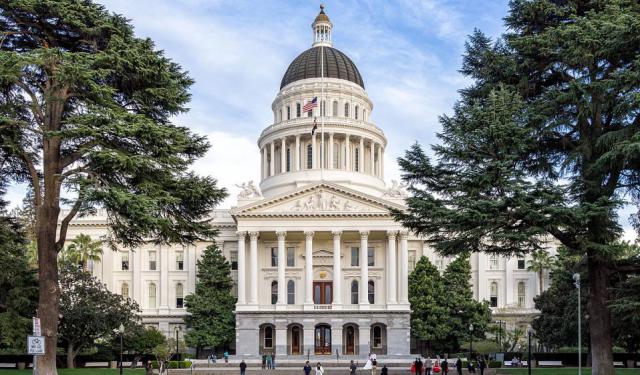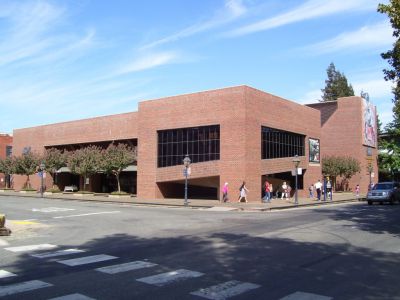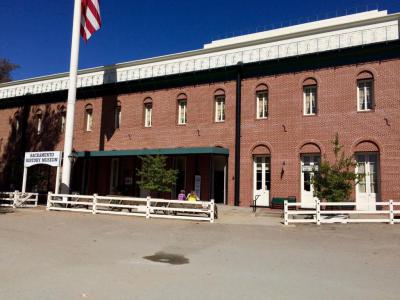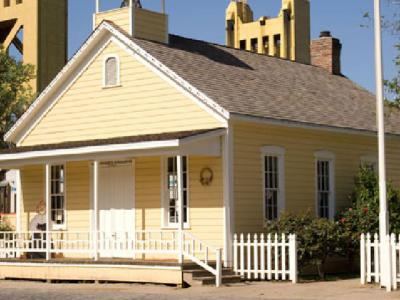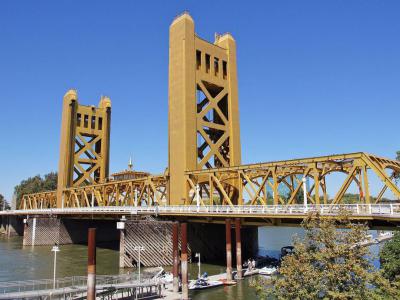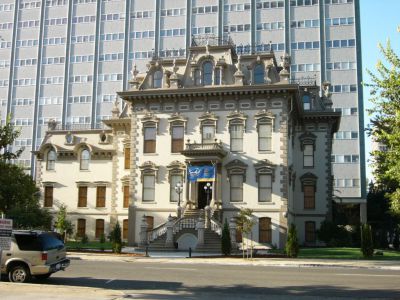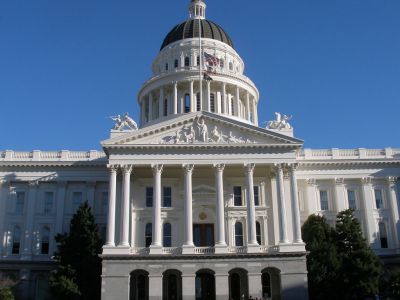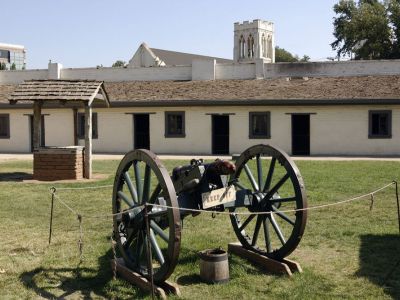Sacramento Introduction Walking Tour (Self Guided), Sacramento
Though little evidence is left now, the Sacramento Valley was home to the Modoc, Plains Miwok, and Nisenan Native American tribes for thousands of years before the arrival of the pioneers and the Spanish. John Sutter Sr. settled at the confluence of the American and Sacramento Rivers, land bequeathed to him by the Mexican government in 1839. He had his eyes on creating an agriculture empire. You can tour Sutter’s Fort today, which is a state park.
It was on Sutter’s land that the first gold was discovered in 1848. That spurred the famous 1849 gold rush and the arrival of the “Forty-Niners” - thousands of pioneers traveling west across the US in search of riches. Sacramento became the original gold rush boomtown.
Around Sutter’s Fort, all sorts of business sprang up to support the influx of settlers. Sacramento was laid out and founded by John Sutter Jr. It is the oldest incorporated town in California and became the seat of state government in 1854.
The community continued to grow, along with the burgeoning US State of California around it. Sacramento marked the western end of the famous Transcontinental Railroad, which you can learn more about at the California State Railroad Museum.
Today, it’s a vibrant and diverse city of art and history. If you like art, don’t miss the Crocker Art Museum. If history is your thing, start at the Sacramento History Museum and tour Old Sacramento. The State Capitol Building, Capitol Park, and the Leland Stanford Mansion are all worth visiting to learn more about the state’s government and the people who have shaped it.
With so much history and culture, and many things to do, it’s no wonder that Sacramento is one of California’s fastest-growing communities. Join us on a self-guided walking tour and learn about California’s original pioneer town.
It was on Sutter’s land that the first gold was discovered in 1848. That spurred the famous 1849 gold rush and the arrival of the “Forty-Niners” - thousands of pioneers traveling west across the US in search of riches. Sacramento became the original gold rush boomtown.
Around Sutter’s Fort, all sorts of business sprang up to support the influx of settlers. Sacramento was laid out and founded by John Sutter Jr. It is the oldest incorporated town in California and became the seat of state government in 1854.
The community continued to grow, along with the burgeoning US State of California around it. Sacramento marked the western end of the famous Transcontinental Railroad, which you can learn more about at the California State Railroad Museum.
Today, it’s a vibrant and diverse city of art and history. If you like art, don’t miss the Crocker Art Museum. If history is your thing, start at the Sacramento History Museum and tour Old Sacramento. The State Capitol Building, Capitol Park, and the Leland Stanford Mansion are all worth visiting to learn more about the state’s government and the people who have shaped it.
With so much history and culture, and many things to do, it’s no wonder that Sacramento is one of California’s fastest-growing communities. Join us on a self-guided walking tour and learn about California’s original pioneer town.
How it works: Download the app "GPSmyCity: Walks in 1K+ Cities" from Apple App Store or Google Play Store to your mobile phone or tablet. The app turns your mobile device into a personal tour guide and its built-in GPS navigation functions guide you from one tour stop to next. The app works offline, so no data plan is needed when traveling abroad.
Sacramento Introduction Walking Tour Map
Guide Name: Sacramento Introduction Walking Tour
Guide Location: USA » Sacramento (See other walking tours in Sacramento)
Guide Type: Self-guided Walking Tour (Sightseeing)
# of Attractions: 7
Tour Duration: 2 Hour(s)
Travel Distance: 4.2 Km or 2.6 Miles
Author: Dee
Sight(s) Featured in This Guide:
Guide Location: USA » Sacramento (See other walking tours in Sacramento)
Guide Type: Self-guided Walking Tour (Sightseeing)
# of Attractions: 7
Tour Duration: 2 Hour(s)
Travel Distance: 4.2 Km or 2.6 Miles
Author: Dee
Sight(s) Featured in This Guide:
- California State Railroad Museum
- Sacramento History Museum
- Old Sacramento Schoolhouse Museum
- Tower Bridge
- Leland Stanford Mansion State Historic Park
- California State Capitol Museum
- Sutter's Fort
1) California State Railroad Museum (must see)
Located at the western terminus of the first transcontinental railroad, the Railroad Museum is part of the larger Old Sacramento State Historic Park. Besides the museum, you'll find many restored and reconstructed buildings here from the mid-1800's–California's boom years. There are a train station and depot, hardware store, theater, and various business buildings.
The state park system operates the Railroad Museum. The museum has exhibits that focus not only on the locomotives and rail cars but also on how trains helped develop California and the West. Since Sacramento played such an essential part in the first transcontinental railroad, it's no surprise that time is dedicated to discussing how the east and west coasts were first connected. The Golden Spike exhibit answers all of your questions and more about the completion of that railroad and the famous opening ceremony in 1869.
Other exhibits focus on the importance of railroads to California's agriculture sector and the diverse populations that helped create and used the railroads. There's a section dedicated to kids and young-at-heart so model railroad enthusiasts won't be let down.
Most notably, the museum is home to 19 different locomotives covering the period between 1862 and 1944. The massive machines visually tell the story of the incredible technological developments that occurred during the golden age of rail travel. There are also rail cars from the same time, including passenger, freight, and maintenance cars.
Why You Should Visit:
The California State Railroad Museum is about a whole lot more than just trains. Railroads were instrumental in California's connection to the rest of the world and an important component of the state's history. By learning about this romantic form of travel and the technological challenges that came with it, visitors will learn the context of the state's history.
Situated in old town Sacramento, with history all around, the Railroad Museum is a top-pick for many visitors to the area.
Tips:
Be sure to look into the museum's excursion train ride. The Sacramento Southern Railroad departs on weekends for a trip along the levees of the Sacramento River. The all-volunteer crews take visitors on a trip back in time to the heyday of California train travel.
The state park system operates the Railroad Museum. The museum has exhibits that focus not only on the locomotives and rail cars but also on how trains helped develop California and the West. Since Sacramento played such an essential part in the first transcontinental railroad, it's no surprise that time is dedicated to discussing how the east and west coasts were first connected. The Golden Spike exhibit answers all of your questions and more about the completion of that railroad and the famous opening ceremony in 1869.
Other exhibits focus on the importance of railroads to California's agriculture sector and the diverse populations that helped create and used the railroads. There's a section dedicated to kids and young-at-heart so model railroad enthusiasts won't be let down.
Most notably, the museum is home to 19 different locomotives covering the period between 1862 and 1944. The massive machines visually tell the story of the incredible technological developments that occurred during the golden age of rail travel. There are also rail cars from the same time, including passenger, freight, and maintenance cars.
Why You Should Visit:
The California State Railroad Museum is about a whole lot more than just trains. Railroads were instrumental in California's connection to the rest of the world and an important component of the state's history. By learning about this romantic form of travel and the technological challenges that came with it, visitors will learn the context of the state's history.
Situated in old town Sacramento, with history all around, the Railroad Museum is a top-pick for many visitors to the area.
Tips:
Be sure to look into the museum's excursion train ride. The Sacramento Southern Railroad departs on weekends for a trip along the levees of the Sacramento River. The all-volunteer crews take visitors on a trip back in time to the heyday of California train travel.
2) Sacramento History Museum
The only museum in the area entirely dedicated to Sacramento and the California Gold Rush, the Sacramento History Museum is ideally situated in the middle of the old town. The collection is housed in a replica building built to represent the town's 1854 City Hall and Waterworks building.
The history museum opened in 1985 to house artifacts from the city and the local science center. Exhibits cover the town's earliest years, from 1839 when settler John Sutter arrived. Old Sacramento sprang up fast after gold was discovered nearby in 1849, with hotels, saloons, and shops where would-be miners could outfit themselves for their mission. That part of town has been faithfully restored to appear as it did in the gold rush era, with gas lamplights and cobblestone streets.
Among the museum's most fascinating exhibits is a view of the Old Sacramento Underground. In the 1860s, the entire city was raised to avoid flooding. The exhibit allows visitors to get a glimpse of this incredible undertaking.
The history museum opened in 1985 to house artifacts from the city and the local science center. Exhibits cover the town's earliest years, from 1839 when settler John Sutter arrived. Old Sacramento sprang up fast after gold was discovered nearby in 1849, with hotels, saloons, and shops where would-be miners could outfit themselves for their mission. That part of town has been faithfully restored to appear as it did in the gold rush era, with gas lamplights and cobblestone streets.
Among the museum's most fascinating exhibits is a view of the Old Sacramento Underground. In the 1860s, the entire city was raised to avoid flooding. The exhibit allows visitors to get a glimpse of this incredible undertaking.
3) Old Sacramento Schoolhouse Museum
Schools were dramatically different in the 19th century. Children were expected to help at home, on the farm, or at the family business, and little emphasis was placed on the importance of formal education. Nowhere was this mentality more true than the rural areas of the old American West. Communities were lucky to have a one-room schoolhouse, where a single schoolmarm taught all grade levels for a few hours every day.
The Schoolhouse Museum allows visitors to look into what school was like in 19th century California. This replica schoolhouse sits in the restored old town area; it's a traditional one-room schoolhouse equipped with a pot-bellied stove, furnishings, and student desks from the era.
The museum is open most weekdays and weekends to the general public. Docents dressed in period-appropriate costumes lead visitors in a lesson as schoolmarms and masters. Kids will enjoy seeing the difference and comparing it with their modern-day experiences.
The Schoolhouse Museum allows visitors to look into what school was like in 19th century California. This replica schoolhouse sits in the restored old town area; it's a traditional one-room schoolhouse equipped with a pot-bellied stove, furnishings, and student desks from the era.
The museum is open most weekdays and weekends to the general public. Docents dressed in period-appropriate costumes lead visitors in a lesson as schoolmarms and masters. Kids will enjoy seeing the difference and comparing it with their modern-day experiences.
4) Tower Bridge
Coming into the city via US Highway 40, it's hard to miss the eye-catching and dramatic Tower Bridge. The vertical lift bridge was opened for traffic in 1935. It replaced the original M Street Bridge, which at only 25 years old was already causing concerns with traffic congestion. The possibility of war and the need for moving supplies from west to east across the US was a significant factor in building the bridge. The original design featured two single-land roadways on either side of central railroad tracks, but the train tracks were removed in the early 1960s.
The 209-foot long lift section of the bridge weighs around five million pounds. Still, the clever use of perfectly balanced counterweights means that two relatively small electric motors can operate the bridge. When the bridge is up, it provides 100 feet of vertical clearance for vessels sailing up the Sacramento River. The towers are 160 feet tall and extend 50 feet below the water surface and into the river bed to provide structural support for the bridge's colossal weight.
The bridge's paint scheme has been changed several times over the years. The present gold color, applied in 2002, was chosen by a local vote.
The 209-foot long lift section of the bridge weighs around five million pounds. Still, the clever use of perfectly balanced counterweights means that two relatively small electric motors can operate the bridge. When the bridge is up, it provides 100 feet of vertical clearance for vessels sailing up the Sacramento River. The towers are 160 feet tall and extend 50 feet below the water surface and into the river bed to provide structural support for the bridge's colossal weight.
The bridge's paint scheme has been changed several times over the years. The present gold color, applied in 2002, was chosen by a local vote.
5) Leland Stanford Mansion State Historic Park (must see)
Completed in 1857 and purchased a few years later by Leland Standford, this four-story house covers over 19,000 square feet. Standford was the co-founder and president of the Central Pacific Railroad, California's eighth governor, and Stanford University founder. The house has been under the care and management of the state parks since 1998. It is still used for official functions by the governor's and legislative offices and is kept open for public tours.
The original owner of the house was local merchant Shelton C. Fogus. He had the home constructed in a distinctive Renaissance Revival architecture style. In 1861, just before he was elected governor, Stanford purchased the home for $8,000. He used the mansion as his executive office and home. The next two governors did the same. Stanford expanded and modified the home greatly to suit his needs and have it raised above flood level.
The home was donated to the Roman Catholic Diocese by Jane Stanford after her husband and son's deaths. It was used as an orphanage for decades before becoming restored to its present showpiece condition.
The mansion was designated a California historic landmark and a National Historic Landmark.
Tips:
Keep in mind that the daily tours of the mansion can be affected by the official functions and events held there. Before heading over, be sure to double-check that tours are available on your planned day.
Enter through the visitor's center on the back of the property. Free guided tours depart hourly from there.
The original owner of the house was local merchant Shelton C. Fogus. He had the home constructed in a distinctive Renaissance Revival architecture style. In 1861, just before he was elected governor, Stanford purchased the home for $8,000. He used the mansion as his executive office and home. The next two governors did the same. Stanford expanded and modified the home greatly to suit his needs and have it raised above flood level.
The home was donated to the Roman Catholic Diocese by Jane Stanford after her husband and son's deaths. It was used as an orphanage for decades before becoming restored to its present showpiece condition.
The mansion was designated a California historic landmark and a National Historic Landmark.
Tips:
Keep in mind that the daily tours of the mansion can be affected by the official functions and events held there. Before heading over, be sure to double-check that tours are available on your planned day.
Enter through the visitor's center on the back of the property. Free guided tours depart hourly from there.
6) California State Capitol Museum (must see)
The capitol building houses the working bicameral state legislature and governor's offices. It was built in 1874, designed to be reminiscent of the US Capitol in Washington DC. The Senate chamber's red decorations refer to the British House of Lords, while the green tones in the Assembly chamber come from their House of Commons.
The basement and first floor of the state capitol building are dedicated as a museum. The tour office is located on the basement level, along with a small theater and gift shop. The first floor consists of several historic offices that have been restored, including those of the Secretary of State, Governor, and Treasurer. There are also rotating exhibits that highlight the history of the state. Forty acres of gardens surround the building, with over 200 types of trees and 155 memorials. The park takes up the space of ten city blocks.
Why You Should Visit:
Besides seeing state governance's operating seat, the capitol also houses an extensive art collection that features hundreds of paintings, statues, murals, and antiques. Items displayed in the West Wing are from 1870 to 1910, known as the interpretive period. The East Annex features art from 1920 to 1950. There are also two noteworthy murals depicting historical events, one in the lower rotunda and one in the East Annex. Throughout the West Wing, you will see portraits of California's 38 governors.
The grounds of the building are worth strolling around. You'll see numerous monuments throughout Capitol Park, dedicated to important events and people from the state's history. Notable are the Camellia Grove, dedicated to the pioneers who settled the state and a gathering place in honor of California Indians.
Tips:
During weekends, you must enter the museum through the N Street entrance. Free public tours depart hourly from 9 am to 4 pm from the tour office located on the basement level seven days a week.
If you're in town during the early spring, check out Camellia Day. More than 800 varieties of the plant grow in Capitol Park, with showy and colorful white, red, pink, and striped flowers.
The basement and first floor of the state capitol building are dedicated as a museum. The tour office is located on the basement level, along with a small theater and gift shop. The first floor consists of several historic offices that have been restored, including those of the Secretary of State, Governor, and Treasurer. There are also rotating exhibits that highlight the history of the state. Forty acres of gardens surround the building, with over 200 types of trees and 155 memorials. The park takes up the space of ten city blocks.
Why You Should Visit:
Besides seeing state governance's operating seat, the capitol also houses an extensive art collection that features hundreds of paintings, statues, murals, and antiques. Items displayed in the West Wing are from 1870 to 1910, known as the interpretive period. The East Annex features art from 1920 to 1950. There are also two noteworthy murals depicting historical events, one in the lower rotunda and one in the East Annex. Throughout the West Wing, you will see portraits of California's 38 governors.
The grounds of the building are worth strolling around. You'll see numerous monuments throughout Capitol Park, dedicated to important events and people from the state's history. Notable are the Camellia Grove, dedicated to the pioneers who settled the state and a gathering place in honor of California Indians.
Tips:
During weekends, you must enter the museum through the N Street entrance. Free public tours depart hourly from 9 am to 4 pm from the tour office located on the basement level seven days a week.
If you're in town during the early spring, check out Camellia Day. More than 800 varieties of the plant grow in Capitol Park, with showy and colorful white, red, pink, and striped flowers.
7) Sutter's Fort (must see)
It all started here and it is, therefore, safe to say that without Sutter's Fort there would have been no Gold Rush in California back in the mid-1800s.
Builder Johann Sutter called his fort "New Helvetia" when he began building it in Mexican Alta California in 1839. The name was a homage to his native Switzerland. It was the first non-indigenous community in California's central valley. Being conveniently located near the California Trail and the Siskiyou Trail, the building was a foundational component of Sacramento's future development.
Sutter left Switzerland in 1834, sailed to the US, and worked his way west as a trader. He even traveled to Alaska and Hawaii while attempting to reinvent himself but eventually decided to settle on the banks of the American River with an eye on agriculture. After constructing the fort and developing the community, Sutter was given Mexican citizenship, a land grant, and was appointed by the governor as captain of the Sacramento troops. Despite being Mexican, Sutter was friendly to American migrants and sentiments.
The fort was the site of the beginning of the gold rush, where James Marshall showed Sutter the gold found during the building of Sutter's sawmill along the American River. After the gold rush had gotten underway, the fort was mostly deserted. Sutter was cheated out of any profits he might have gained from the gold rush and wound up selling the fort and losing all of his holdings.
Towards the end of the 19th century, many citizens worked to protect landmarks from the pioneer days. The fort was repaired and under the Native Sons of the Golden West's management for many years and then transferred to the state park system in 1947.
Why You Should Visit:
The California Parks and Recreation Department has restored the main building of the fort to its original condition. It's open daily for self-guided tours. You'll find period furnishings, exhibits, and a trade store. The original fort housed a bakery, grist mill, blanket factory, gunsmith, and blacksmith shop. Up to 300 people worked in and lived around the fort. The restored fort provides a glimpse into what life was like for early settlers and pioneers.
Tips:
Check out the park's website for information on their "Living History Days" that reenact and recreate life during Sutter's time. Also, don't miss the trade store, which houses crafts, books, and gifts that transport visitors back in time.
Builder Johann Sutter called his fort "New Helvetia" when he began building it in Mexican Alta California in 1839. The name was a homage to his native Switzerland. It was the first non-indigenous community in California's central valley. Being conveniently located near the California Trail and the Siskiyou Trail, the building was a foundational component of Sacramento's future development.
Sutter left Switzerland in 1834, sailed to the US, and worked his way west as a trader. He even traveled to Alaska and Hawaii while attempting to reinvent himself but eventually decided to settle on the banks of the American River with an eye on agriculture. After constructing the fort and developing the community, Sutter was given Mexican citizenship, a land grant, and was appointed by the governor as captain of the Sacramento troops. Despite being Mexican, Sutter was friendly to American migrants and sentiments.
The fort was the site of the beginning of the gold rush, where James Marshall showed Sutter the gold found during the building of Sutter's sawmill along the American River. After the gold rush had gotten underway, the fort was mostly deserted. Sutter was cheated out of any profits he might have gained from the gold rush and wound up selling the fort and losing all of his holdings.
Towards the end of the 19th century, many citizens worked to protect landmarks from the pioneer days. The fort was repaired and under the Native Sons of the Golden West's management for many years and then transferred to the state park system in 1947.
Why You Should Visit:
The California Parks and Recreation Department has restored the main building of the fort to its original condition. It's open daily for self-guided tours. You'll find period furnishings, exhibits, and a trade store. The original fort housed a bakery, grist mill, blanket factory, gunsmith, and blacksmith shop. Up to 300 people worked in and lived around the fort. The restored fort provides a glimpse into what life was like for early settlers and pioneers.
Tips:
Check out the park's website for information on their "Living History Days" that reenact and recreate life during Sutter's time. Also, don't miss the trade store, which houses crafts, books, and gifts that transport visitors back in time.
Walking Tours in Sacramento, California
Create Your Own Walk in Sacramento
Creating your own self-guided walk in Sacramento is easy and fun. Choose the city attractions that you want to see and a walk route map will be created just for you. You can even set your hotel as the start point of the walk.
Historical Buildings Walking Tour
The Gold Rush of the mid-1800s brought a large number of gold miners and prospects to Sacramento. The city expanded further when the California State Legislature moved here in 1854. Some of Sacramento’s historic buildings date back to that period and used to accommodate the flood of gold seekers and growing government business.
The elegant Governor's Mansion State Historic Park once... view more
Tour Duration: 2 Hour(s)
Travel Distance: 3.5 Km or 2.2 Miles
The elegant Governor's Mansion State Historic Park once... view more
Tour Duration: 2 Hour(s)
Travel Distance: 3.5 Km or 2.2 Miles
The Most Popular Cities
/ view all
